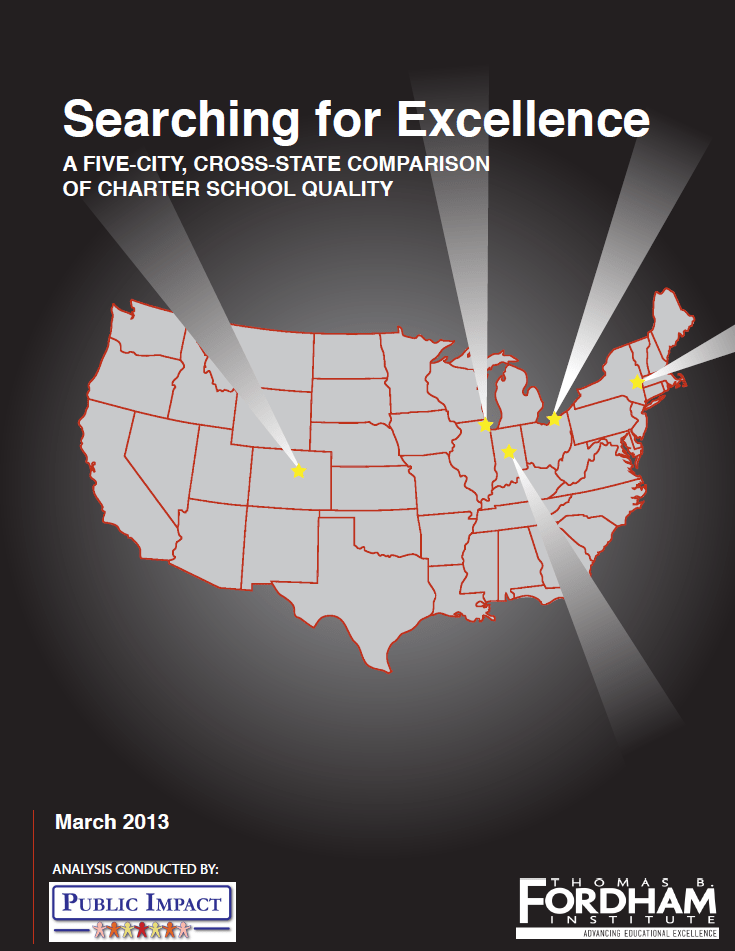In just two decades charter schools have grown from a boutique school reform strategy to an alternative public school system serving a significant percentage of the nation’s K-12 students. In 1996, just 19 states had charter legislation in place, and there were only about 250 charters serving some 20,000 pupils. Fast forward to 2013: 41 states and the District of Columbia now have charter laws on the books, and there are more than 2 million students enrolled in 5,600 charter schools.
According to the National Alliance for Public Charter Schools, seven school districts in the nation have at least 30 percent of their public school students enrolled in public charter schools (in Fordham’s home state of Ohio Cleveland, Dayton, Toledo and Youngstown each have 25 percent or more of their students enrolled in charters). An additional 18 districts have 20 percent or more of their public school students enrolled in charter schools. And, there are now more than 100 districts across the country with at least 10 percent of public school students enrolled in charters. Charter schools are undeniably one of the most popular and growing school reforms of the last 25 years.
But, there is still much work to be done, especially when it comes to improving student achievement in the nation’s charter schools. The fact is that the quality of charter schools remains uneven. While there are hundreds of high-performing charter schools across the country serving some of the nation’s neediest students there are an equal number of charters failing to deliver academically. It was in recognition of this mixed performance that the National Association of Charter School Authorizers (NACSA) launched its One Million Lives campaign in late 2012.
NACSA captured the challenge when it observed, “even after two decades of chartering, too many students fail to graduate and too few students are academically prepared for success. While many charter schools perform at the highest levels, many others perform at the lowest levels. Charter schools are not the only solution in public education, but they shouldn’t be part of the problem.”
The Thomas B. Fordham Institute, and its sister organization the Thomas B. Fordham Foundation, have long advocated for quality charter schools. Even more, in Ohio we authorize 11 schools across the state, which collectively serve about 2,500 students. But, we’ve long been equally frustrated by the mixed academic performance of charters. Mirroring national trends, Ohio has some fantastic charters but it also has too many laggards among its 360 plus schools. Even Fordham’s sponsorship portfolio of charter schools is something of a mixed bag academically.
The variability of charter school quality demands a response, both to boost and replicate great charters and to determine ways for making smart decisions about those charters that should be closed. So, in order to better understand charter school performance and ways to improve it we asked the crack research team at Public Impact in Chapel Hill, North Carolina to take a fresh look at the performance of charter schools in five US cities: Albany, Chicago, Cleveland, Denver, and Indianapolis. We chose these cities because they all have relatively large percentages of students enrolled in charter schools, and they are well known for their recent school reform efforts that include extensive support for charters.
Using building-level achievement data, we asked Public Impact to answer some basic questions. First, how do charters in these five cities compare academically to their district peers within the cities they are located? Are they outperforming them, doing about the same, or performing at lower levels? Has, we wondered, any of these cities figured out how to help make all, or at least most, of their charters high-performers?
Second, how are charters in these cities doing in comparison to district schools across their state? Are they outperforming state averages, matching them, or failing to match state averages? Can, we wondered, charters succeed at scale in not only helping students outperform their long-suffering urban peers but compete effectively against their wealthier suburban peers? In short, have any of these cities created charter sectors that have found the magic formula for closing the achievement gap?
Third, and most interestingly, what might be the impact on student achievement in these cities’ charter schools, if the bottom ten percent of performers were closed while the top performers were given support to expand their market share by an equal percentage? Can a strategic charter closure policy matched by policies that support the expansion and growth of high quality charters be the elixir for improving student performance in these big cities?
Searching for Excellence seeks to answer these questions in order to help these five cities, and others, come up with ideas and policies for improving their charter sectors. For too long, district schools in our big cities have been impervious to any serious improvement efforts. By design, however, the charter sector is more nimble and adaptable and as such should be more malleable to improvement efforts. The data certainly provide an imperative for bold action to improve charter quality—and, in turn, provide greater opportunity for the students who attend them.


